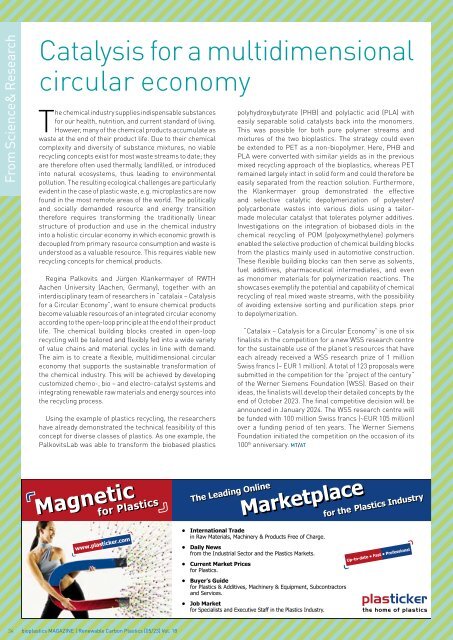Issue 05/2023
Highlights Fibres / Textiles Polyurethane / Elastomers
Highlights
Fibres / Textiles
Polyurethane / Elastomers
Create successful ePaper yourself
Turn your PDF publications into a flip-book with our unique Google optimized e-Paper software.
From Science& Research Category<br />
Catalysis for a multidimensional<br />
circular economy<br />
The chemical industry supplies indispensable substances<br />
for our health, nutrition, and current standard of living.<br />
However, many of the chemical products accumulate as<br />
waste at the end of their product life. Due to their chemical<br />
complexity and diversity of substance mixtures, no viable<br />
recycling concepts exist for most waste streams to date; they<br />
are therefore often used thermally, landfilled, or introduced<br />
into natural ecosystems, thus leading to environmental<br />
pollution. The resulting ecological challenges are particularly<br />
evident in the case of plastic waste, e.g. microplastics are now<br />
found in the most remote areas of the world. The politically<br />
and socially demanded resource and energy transition<br />
therefore requires transforming the traditionally linear<br />
structure of production and use in the chemical industry<br />
into a holistic circular economy in which economic growth is<br />
decoupled from primary resource consumption and waste is<br />
understood as a valuable resource. This requires viable new<br />
recycling concepts for chemical products.<br />
Regina Palkovits and Jürgen Klankermayer of RWTH<br />
Aachen University (Aachen, Germany), together with an<br />
interdisciplinary team of researchers in “catalaix – Catalysis<br />
for a Circular Economy”, want to ensure chemical products<br />
become valuable resources of an integrated circular economy<br />
according to the open-loop principle at the end of their product<br />
life. The chemical building blocks created in open-loop<br />
recycling will be tailored and flexibly fed into a wide variety<br />
of value chains and material cycles in line with demand.<br />
The aim is to create a flexible, multidimensional circular<br />
economy that supports the sustainable transformation of<br />
the chemical industry. This will be achieved by developing<br />
customized chemo-, bio – and electro-catalyst systems and<br />
integrating renewable raw materials and energy sources into<br />
the recycling process.<br />
Using the example of plastics recycling, the researchers<br />
have already demonstrated the technical feasibility of this<br />
concept for diverse classes of plastics. As one example, the<br />
PalkovitsLab was able to transform the biobased plastics<br />
polyhydroxybutyrate (PHB) and polylactic acid (PLA) with<br />
easily separable solid catalysts back into the monomers.<br />
This was possible for both pure polymer streams and<br />
mixtures of the two bioplastics. The strategy could even<br />
be extended to PET as a non-biopolymer. Here, PHB and<br />
PLA were converted with similar yields as in the previous<br />
mixed recycling approach of the bioplastics, whereas PET<br />
remained largely intact in solid form and could therefore be<br />
easily separated from the reaction solution. Furthermore,<br />
the Klankermayer group demonstrated the effective<br />
and selective catalytic depolymerization of polyester/<br />
polycarbonate wastes into various diols using a tailormade<br />
molecular catalyst that tolerates polymer additives.<br />
Investigations on the integration of biobased diols in the<br />
chemical recycling of POM (polyoxymethylene) polymers<br />
enabled the selective production of chemical building blocks<br />
from the plastics mainly used in automotive construction.<br />
These flexible building blocks can then serve as solvents,<br />
fuel additives, pharmaceutical intermediates, and even<br />
as monomer materials for polymerization reactions. The<br />
showcases exemplify the potential and capability of chemical<br />
recycling of real mixed waste streams, with the possibility<br />
of avoiding extensive sorting and purification steps prior<br />
to depolymerization.<br />
“Catalaix – Catalysis for a Circular Economy” is one of six<br />
finalists in the competition for a new WSS research centre<br />
for the sustainable use of the planet’s resources that have<br />
each already received a WSS research prize of 1 million<br />
Swiss francs (~ EUR 1 million). A total of 123 proposals were<br />
submitted in the competition for the “project of the century”<br />
of the Werner Siemens Foundation (WSS). Based on their<br />
ideas, the finalists will develop their detailed concepts by the<br />
end of October <strong>2023</strong>. The final competitive decision will be<br />
announced in January 2024. The WSS research centre will<br />
be funded with 100 million Swiss francs (~EUR 1<strong>05</strong> million)<br />
over a funding period of ten years. The Werner Siemens<br />
Foundation initiated the competition on the occasion of its<br />
100 th anniversary. MT/AT<br />
Magnetic<br />
for Plastics<br />
www.plasticker.com<br />
• International Trade<br />
in Raw Materials, Machinery & Products Free of Charge.<br />
• Daily News<br />
from the Industrial Sector and the Plastics Markets.<br />
• Current Market Prices<br />
for Plastics.<br />
• Buyer’s Guide<br />
for Plastics & Additives, Machinery & Equipment, Subcontractors<br />
and Services.<br />
• Job Market<br />
for Specialists and Executive Staff in the Plastics Industry.<br />
Up-to-date • Fast • Professional<br />
34 bioplastics MAGAZINE | Renewable Carbon Plastics [<strong>05</strong>/23] Vol. 18

















